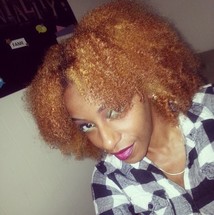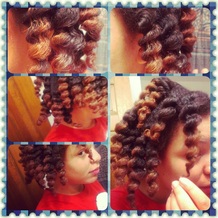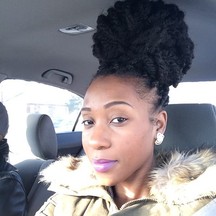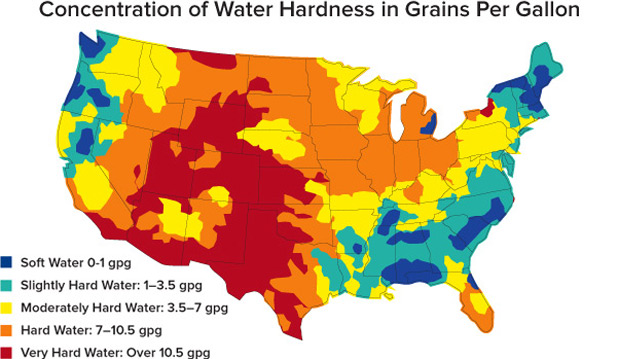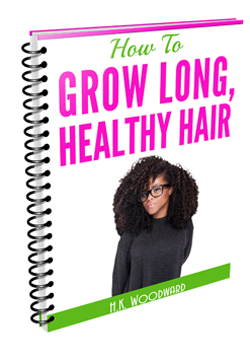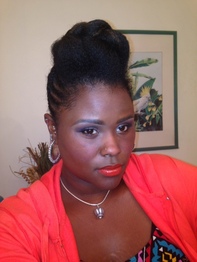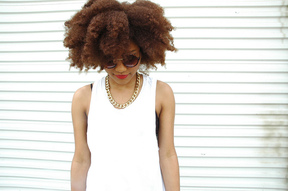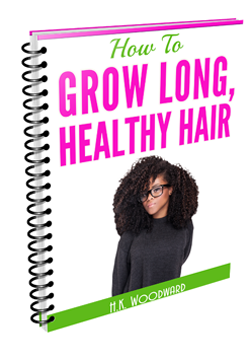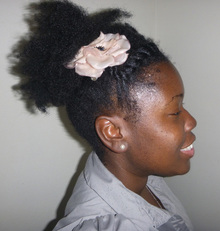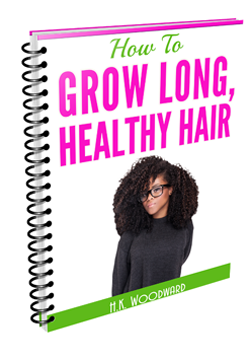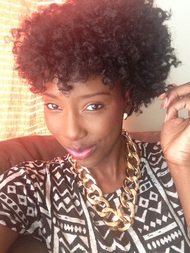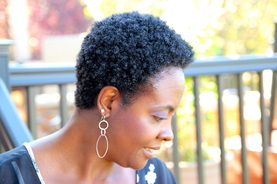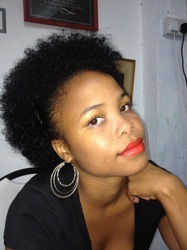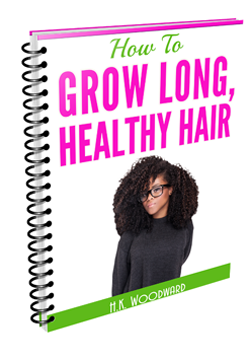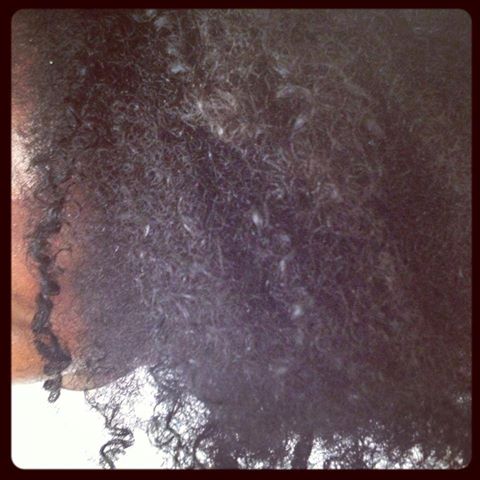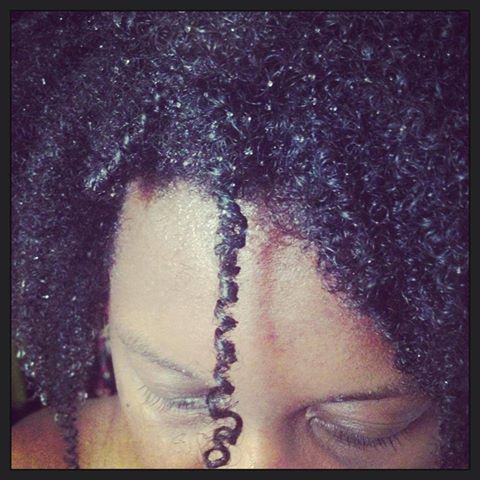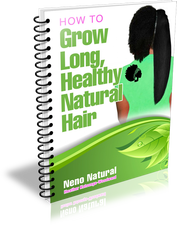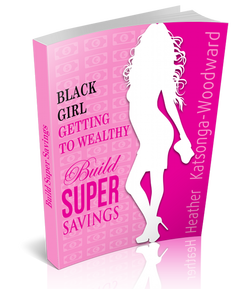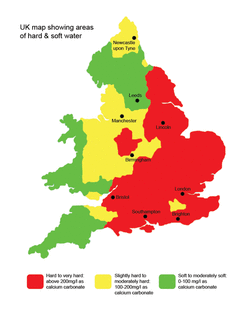 Do you live in an area with hard water? Do you live in an area with hard water?
Watch the video!
Put tersely, hard water damages hair. Hard water has a large quantity of calcium, magnesium, iron and copper. It’s this high concentration of minerals that damages hair.[i] Washing hair in hard water causes it to become/feel straw-like, dry and brittle; it’s likely that your hair will break or start thinning because the hair follicles become blocked thereby preventing the flow of nutrients to the scalp. Your scalp may also become dry and flaky. Click one of the maps to see if you live in an area with hard water. 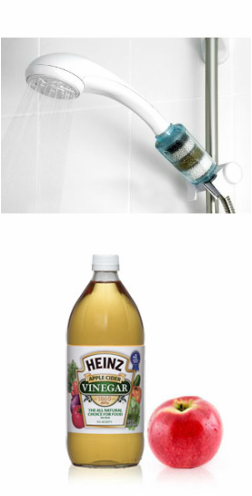
Don’t despair, there are some simple solutions to the hard water problem.
4. Add the juice of a lemon to water. Squeezing lemon juice into water can help to reduce the water's hardness. However, note that the pH of lemon juice is 2, i.e., it’s very acidic so you should dilute it in water (pH = 7) to reduce its acidity before applying it to hair. Healthy hair has a pH of 4.0 to 5.5. 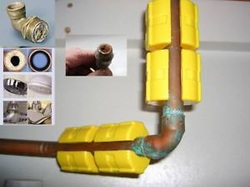 Magnetic Water Conditioner Magnetic Water Conditioner
How about magnetic water conditioners?
These devices allegedly reduce lime scale; they are fitted to a pipe in the house and are reputed to benefit not only your hair but also other appliances whose function can be reduced by limescale, e.g. the central heating system, boiler and dishwasher. However, although some argue that they work, the US Navy did a series of tests to check the effectiveness of ‘magnetic’ and ‘electric’ water softeners. They concluded that they have no effect at all. It appears that although the limescale is removed from water that come out the tap, that limescales stays in the pipes ultimately leading to problems with the heating system. “Magnetic lime scale reducers are a plumber's dream,” according to one Amazon product reviewer. How about chelating shampoos? Chelating shampoos prevent and remove mineral build-up but they strip hair of all the good stuff too so I personally wouldn’t recommend them. Even on Caucasian hair, a chelating shampoo should not be used more than once a week. [i] How to Prevent Hair Build-up from Water
Highly rated shower heads with water filters:
This is one issue you may not have thought about before. When hair is wet, it’s very elastic and can stretch out much further than it can when it is dry.
As hair dries, it shrinks back to its normal length. This is a problem if you style your hair into a fixed style while it’s wet. Ponytails / Buns / Puffs For example, if you pull your natural hair into a ponytail, bun or puff while it’s wet in a way that it can’t shrink back easily then as the hair dries and shrinks it could pull on the edges so much that the roots are weakened and could be pulled out more easily with additional styling. The area where you band/tie your hair may also weaken because it’s prevented from shrinking back to position. Over time, if you always tie your hair in exactly the same place, this hair will weaken because it’s always restricted from shrinking and ultimately break. This is called “wet holder stress” (The Science of Black Hair by Audrey Davis-Sivasothy). Solution
Stretching Hair Use twists and plaits to stretch and dry your hair, these styles are flexible and don’t completely hold hair back when it’s trying to shrink back, they simply limit how much it can shrink. Cornrows and Flat Twists Cornrows and flat twists have the potential to be very restrictive in allowing hair to shrink back. My solution? I dry my hair in twists then when it’s dried or just damp I release the hair and plait the cornrows. This way it is stretched enough to style but wet holder stress is avoided. Kinky and curly hair is a lot more stretchy than already straight hair so the stresses we impose on kinky-curly hair when it’s wet compared to when it is dry have more consequences. Have you had experience with wet holder stress? Comment and tell me about it.
Once you’re firmly past the TWA stage, even if you can’t tie you hair all in one place it’s best to wash your hair in 4 to 8 twists to minimize breakage. Once you master the technique it doesn’t take much time at all.
WHY TWIST DURING THE WASG PROCESS? 1. Tangling Is Reduced When hair strands are bound together in a twist individual hairs can’t wander off and tangle around neighbouring hair. Less tangling means less breakage. 2. Tensile Strength Is Higher There is strength in numbers. The twist as a whole is stronger than any individual strand. You can compare this to pieces of paper. When you receive a load of mail and you tear a single letter it’s easy right? However when you try to tear just 5 pieces if paper in one go it’s a lot more challenging, correct? Increase this to 10 papers and it’s even harder. This analogy also works if you use a shredder: a single piece goes through very quickly but 3 pieces go through much more slowly; increase this to 6 pieces of paper and your shredder gets jammed. When Should You Start Twisting Your Natural Hair During The Wash Process? When your hair is getting long enough such that you recognize tangling as a problem; this will happen earlier for some people and later for others. If it happens early for you, use more twisted sections. As hair gets longer you’ll be able to work with fewer twisted sections. At What Point In The Wash Process Should You Twist Your Natural Hair? Right at the beginning of your wash process when you’re detangling. Should you undo each twist as you wash the section? You can but you don’t have to. You will minimize breakage best by leaving the twist intact; that said, ensure that you wash the twist thoroughly to get product out. Make each twist looser at the roots and tighter at the ends. The looseness near the roots will make it easier to massage the scalp and dislodge any oils and dirt there; the tightness of the ends will help to prevent the twist from getting undone. Normally, when I am in the shower I have to redo the ends because they start coming undone – that is normal. In summary, to minimize breakage, twist hair during your wash. If you have thicker/course strands you may find that twisting makes little difference to breakage but it should still help with maintaining detangled strands. Leave any thoughts or comments, please.
You cannot deep condition your hair using a regular conditioner. That’s the first thing you need to keep in mind. A regular conditioner only acts on the surface of hair and does not have the ability to penetrate any further.
If your hair is damaged it means the cuticle layer is uneven. In this case you need a deep conditioner to penetrate through to the damaged areas for repair and maintenance. This repair and maintenance is not permanent, it only last a few days, that is why you need to deep condition at least weekly. Overall, a regular conditioner:
And a deep conditioner also:
What about if your hair is healthy? Is a deep conditioner still needed? If your hair is healthy the cuticles are lie flat and don’t have holes and gaps of damage. This means that a deep conditioner will mostly act on the surface; however, as damage can’t be observed by the naked eye, any small areas of damage will be fixed. With healthy hair a weekly deep condition is not vital but it will definitely help to maintain the healthy condition of your hair. Deep conditioning healthy hair is similar to a person with a fabulous diet also taking a vitamin pill – it isn’t necessary but it ensures they are definitely getting everything their body needs.
|
I now blog about wealth creation - so if you have any money questions meet me there, you can do all sorts of cool things like leave me a voicemail.
By Heather Katsonga-Woodward
I was a natural hair blogger and mixtress living between London & Chicago from 2012 to 2017. I always thought I was 4C but some say 4B; images below - you decide! Heather xx Categories
All
Archives
November 2016
|

